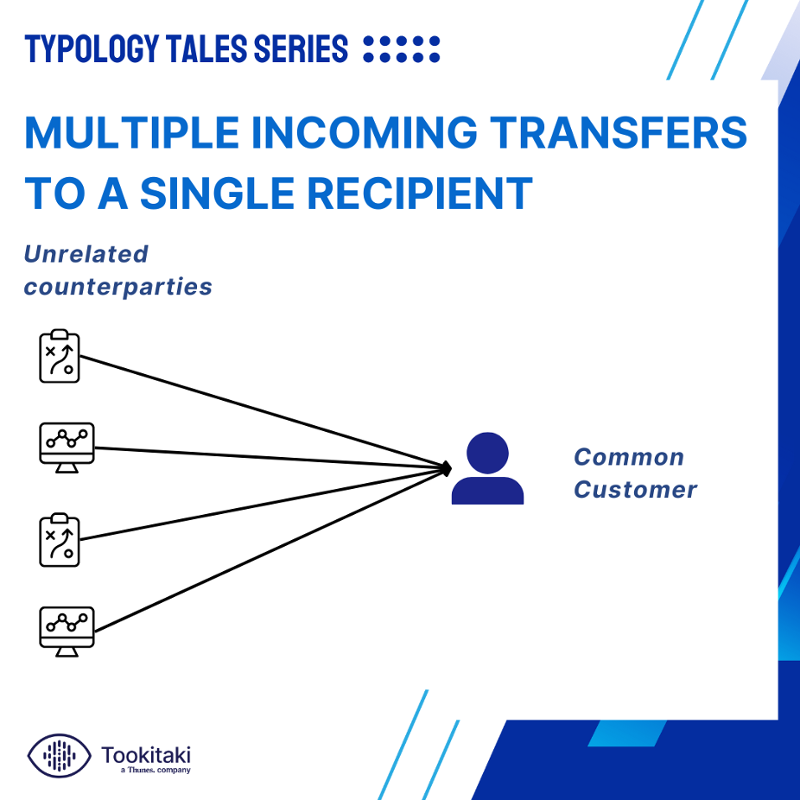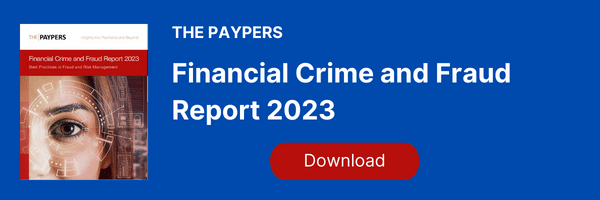Typology Tales: Multiple Incoming Transfers to a Single Recipient
Financial crimes, encompassing a range of illicit activities from money laundering to terrorism financing, continue to evolve as fraudsters and terrorists exploit the latest technological advancements to mask their operations. According to the United Nations Office on Drugs and Crime, the estimated amount of money laundered globally in one year is 2 - 5% of global GDP, or $800 billion to $2 trillion. This staggering amount underlines the sophistication and scale of financial crimes, pushing regulatory bodies and financial institutions to constantly innovate to stay one step ahead of these illicit activities.
One such innovative method employed by fraudsters involves conducting a flurry of small transactions directed at a single recipient. This pattern is particularly suspicious as it often signifies the layering stage of money laundering, where the origin of illicit funds is obscured through a complex series of transactions. The goal is to stay below reporting thresholds and avoid detection, a technique that has been increasingly observed in the use of digital wallets, prepaid cards, and wire transfers. Such scenarios not only raise red flags for potential money laundering but also, in some cases, point towards financing of terrorism, highlighting the need for vigilant monitoring and advanced analytical tools to detect and prevent these sophisticated schemes.
Understanding the Typology
The Scenario Explained
- In this scenario, a single recipient account becomes the target of a rapid series of small transactions, each varying from as low as $10 to a few hundred dollars.
- These transactions originate from diverse geographic locations and are sent by multiple, seemingly unrelated counterparties.
- This activity pattern deviates significantly from the recipient's historical transaction behavior, marking a sudden and unexplained increase in financial activity.

Why This Raises Red Flags
- Layering Stage of Money Laundering: The described scenario is emblematic of the layering phase in money laundering, where illicit funds are broken down and dispersed through complex, hard-to-trace transactions. This dispersal is intended to obscure the illegal origin of the funds and integrate them back into the economy as legitimate.
- Below Threshold Structuring: By keeping transaction amounts small, fraudsters aim to avoid detection by staying below the threshold that triggers mandatory reporting by financial institutions. Such structuring is a common tactic to evade anti-money laundering (AML) controls.
- Indicative of Broader Schemes: Beyond money laundering, this pattern can also suggest terrorism financing, where small, inconspicuous transactions fund illegal activities without attracting attention. The involvement of unrelated counterparties across different locations further complicates tracing the funds back to their source, making it a sophisticated strategy employed by those looking to finance terrorism or launder money.
This transaction pattern warrants close scrutiny due to its association with advanced financial crime strategies. Financial institutions must employ equally sophisticated detection and analysis tools to identify and investigate such typologies effectively.
Identifying Key Red Flags
In the context of detecting and preventing financial crimes, certain patterns of activity can serve as significant indicators of illicit behavior. The scenario described offers a clear illustration of such red flags:
- Multiple Incoming Transactions: An unusual volume of incoming transactions directed at a single recipient, particularly when these transactions are from various unrelated senders, signals a potential attempt to obscure the movement of funds.
- Structuring of Amounts: Transactions are deliberately kept small, often below a certain threshold, to avoid triggering financial institutions' mandatory reporting requirements. This tactic, known as "smurfing", is a classic hallmark of money laundering efforts.
- Deviation from Historical Transaction Behavior: A sudden and uncharacteristic change in the transaction activity of an account, such as receiving many small payments when the historical pattern shows infrequent or larger transactions, indicates potential money laundering or fraud.
Financial instruments and methods commonly exploited in these schemes include:
- Digital Wallets: The digital nature of these wallets allows for rapid, often international, transactions that can easily be obscured among legitimate transactions.
- Prepaid Cards: These cards can be loaded with money laundered through small transactions and then used like regular debit or credit cards, making the illicit funds more difficult to trace.
- Wire Transfers: Despite being a traditional banking method, wire transfers are still used in layering schemes due to their ability to move funds quickly across borders.
The exploitation of these financial instruments in the described scenario underlines the sophistication of modern financial crimes. It also highlights the importance of financial institutions adopting advanced monitoring and analysis tools to detect and combat such illicit activities effectively.
The Role of the AFC Ecosystem in Detecting and Preventing Such Activities
Tookitaki's Anti-Financial Crime (AFC) Ecosystem stands at the forefront of innovative solutions designed to monitor and combat complex financial crimes, including the sophisticated schemes exemplified by a flurry of small transactions to a single recipient. This comprehensive platform integrates advanced analytics and a broad spectrum of data to provide real-time monitoring and detection capabilities. By focusing on the nuances of transaction behaviors and patterns, the AFC Ecosystem enables financial institutions to identify and scrutinize suspicious activities that deviate from historical norms, ensuring that emerging threats are identified swiftly and accurately.
The strength of the AFC Ecosystem lies in its community-driven approach, which pools insights and data from a wide network of financial crime experts and institutions. This collaborative environment fosters a dynamic exchange of information and strategies, enhancing the collective ability to detect and respond to financial crimes. Advanced analytics play a crucial role in this process, enabling the analysis of vast datasets to identify subtle signs of illicit activity, including the structuring techniques often used in money laundering and terrorism financing. Through the power of this community and the analytical tools at its disposal, the AFC Ecosystem not only uncovers the sophisticated methods employed by criminals but also empowers its members to implement effective countermeasures, safeguarding the integrity of the financial system.
Wrapping Up
Understanding and identifying complex transaction patterns is crucial in the ongoing battle against financial crimes. As criminals continue to employ more sophisticated methods to obscure illicit funds, financial institutions must evolve their strategies to stay one step ahead. The flurry of small, seemingly unrelated transactions to a single recipient is just one example of the innovative tactics used, highlighting the necessity for vigilance and advanced detection capabilities.
To fortify defenses against these sophisticated financial crimes, it is imperative for financial institutions to embrace community-driven approaches and leverage advanced analytics. The AFC Ecosystem, developed by Tookitaki, provides an exemplary framework for this, combining the collective intelligence of a global network of financial crime fighters with state-of-the-art technological solutions. By participating in such ecosystems, financial institutions can access a wealth of shared knowledge and insights, enabling them to detect and prevent financial crimes more effectively.
Therefore, we call upon financial institutions and financial crime enthusiasts alike to join the AFC Ecosystem. Through collaboration and the use of advanced analytical tools, we can enhance our collective ability to protect the financial system from the threats of money laundering, terrorism financing, and other financial crimes.
Anti-Financial Crime Compliance with Tookitaki?




